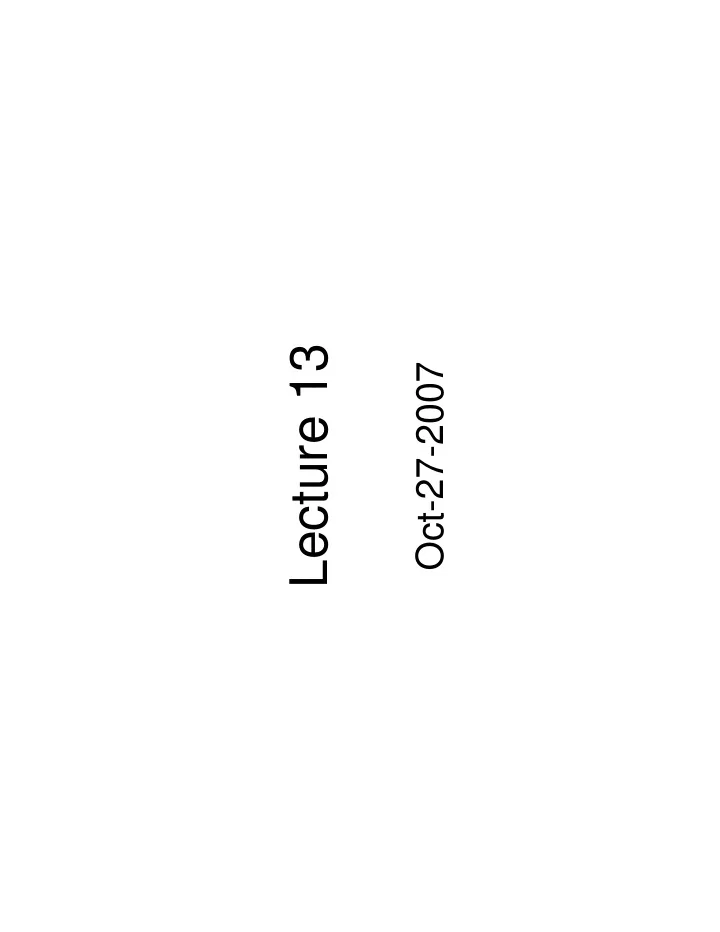

Lecture 13 Lecture 13 Oct-27-2007
Bagging Bagging • Generate T random sample from training set by b bootstrapping t t i • Learn a sequence of classifiers h 1 ,h 2 ,…,h T from each of them using base learner L each of them, using base learner L • To classify an unknown sample X, let each classifier predict classifier predict. • Take simple majority vote to make the final prediction. p Simple scheme, works well in many situations!
Bias/Variance for classifiers Bias/Variance for classifiers • Bias arises when the classifier cannot represent the true function – that is the classifier underfits the data function that is, the classifier underfits the data • Variance arises when the classifier overfits the data – minor variations in training set cause the classifier to overfit differently • Clearly you would like to have a low bias and low variance classifier! – Typically, low bias classifiers (overfitting) have high variance T i ll l bi l ifi ( fitti ) h hi h i – high bias classifiers (underfitting) have low variance – We have a trade-off
Effect of Algorithm Parameters on Bias and Variance • k-nearest neighbor: increasing k typically increases bias and reduces variance • decision trees of depth D: increasing D typically increases variance and reduces bias
Why does bagging work? Why does bagging work? • Bagging takes the average of multiple Bagging takes the average of multiple models --- reduces the variance • This suggests that bagging works the best • This suggests that bagging works the best with low bias and high variance classifiers
Boosting Boosting • Also an ensemble method: the final prediction is a p combination of the prediction of multiple classifiers. • What is different? – Its iterative. Boosting: Successive classifiers depends upon its predecessors - look at errors from previous classifiers to decide what to focus on for the next iteration over data f f Bagging : Individual classifiers were independent. – All training examples are used in each iteration, but with different weights – more weights on difficult sexamples. (the ones on which we committed mistakes in the previous iterations)
Adaboost: Illustration Adaboost: Illustration H(X) H(X) h ( ) h m (x) h M (x) Update weights h (x) h 3 (x) Update weights h 2 (x) Update weights Update weights h 1 (x) Original data: uniformly weighted uniformly weighted
The AdaBoost Algorithm CS434 Fall 2007
The AdaBoost Algorithm
AdaBoost(Example) AdaBoost(Example) Original Training set : Equal Weights to all training samples g g p Taken from “ A Tutorial on Boosting” by Yoav Freund and Rob Schapire
AdaBoost(Example) AdaBoost(Example) ROUND 1
AdaBoost(Example) AdaBoost(Example) ROUND 2 ROUND 2
AdaBoost(Example) AdaBoost(Example) ROUND 3
AdaBoost(Example) AdaBoost(Example)
Weighted Error Weighted Error • Adaboost calls L with a set of prespecified weights • It is often straightforward to convert a base learner L to take • It is often straightforward to convert a base learner L to take into account an input distribution D . Decision trees? i i K Nearest Neighbor? g Naïve Bayes? • When it is not straightforward we can resample the training data S according to D and then feed the new data set into the learner. S cco d g o d e eed e ew d se o e e e .
Boosting Decision Stumps Boosting Decision Stumps Decision stumps: very simple rules of thumb that test condition on a single attribute. diti i l tt ib t Among the most commonly used base classifiers – truly weak! Boosting with decision stumps has been shown to achieve better performance compared to unbounded decision trees.
Boosting Performance • Comparing C4.5, boosting decision stumps, boosting C4.5 using 27 UCI data set – C4.5 is a popular decision tree learner
Boosting vs Bagging of Decision Trees T i i f D
Overfitting? Overfitting? • Boosting drives training error to zero, will it overfit? • Curious phenomenon C i h • Boosting is often robust to overfitting (not always) g g ( y ) • Test error continues to decrease even after training error goes to zero
Explanation with Margins L L ∑ = ⋅ f ( x ) w h ( x ) l l = l 1 Margin = y ⋅ f(x) Histogram of functional margin for ensemble just after achieving zero training error
Effect of Boosting: M Maximizing Margin i i i M i No examples Margin with small margins!! Even after zero training error the margin of examples increases. This is one reason that the generalization error may continue decreasing.
Bias/variance analysis of Boosting Bias/variance analysis of Boosting • In the early iterations boosting is primary In the early iterations, boosting is primary a bias-reducing method • In later iterations it appears to be primarily • In later iterations, it appears to be primarily a variance-reducing method
What you need to know about ensemble methods? bl h d ? • Bagging: a randomized algorithm based on bootstrapping – What is bootstrapping – Variance reduction – What learning algorithms will be good for bagging? Wh t l i l ith ill b d f b i ? • Boosting: – Combine weak classifiers (i.e., slightly better than random) ( , g y ) – Training using the same data set but different weights – How to update weights? – How to incorporate weights in learning (DT, KNN, Naïve Bayes) – One explanation for not overfitting: maximizing the margin
Recommend
More recommend